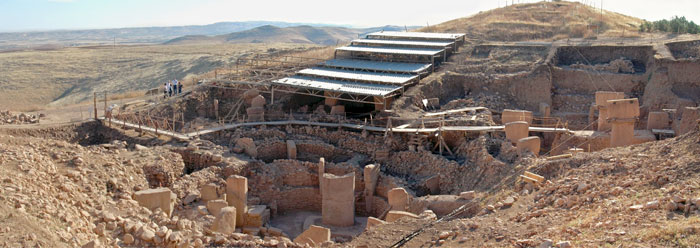"Anthropologists have assumed that organized religion began as a way of salving the tensions that inevitably arose when hunter-gatherers settled down, became farmers, and developed large societies," according to a National Geographic feature in June 2011.1 But the exquisitely carved pillars of the world's oldest known temple, Gobekli Tepe, contradict that evolutionary version of ancient human history.2
Standard evolutionary anthropology—the study of ancient man—insists that humans invented religious worship as they emerged from an ape-like ancestry. Religion supposedly emerged after the development of agriculture provided people with enough free time and close proximity to bicker, thus also providing them with an incentive to invent God and religion.
Evolutionary storytellers such as H. G. Wells provided possible reasons why early humans developed religion. In 1939, Wells speculated about Neolithic peoples:
Tabu, that is to say primitive moral control, and magic, which is primitive science, are now grouped about the directive priesthood, and an elaborate astronomy fraught with worship, links the plough and the labouring beast and the sacrifice upon the altar with then constellations.3
Similarly speculative, the National Geographic's report on Gobekli Tepe asserted that "those who rose to power were seen as having a special connection with the gods."2
But the idea that agricultural amenities spawned religion is making an about-face in light of the fully constructed temple complexes discovered at Gobekli Tepe (pronounced Guh-behk-lee Teh-peh and roughly translated "potbelly hill") in southern Turkey. The remarkable findings there show that mankind was able to worship from the beginning of the human race.
Many mysteries surround the temple site. Nobody knows why the pillars at the complex were buried on purpose, perhaps centuries after their careful construction, or why they depict stylized ornamental patterns, as well as images of birds, snakes, a scorpion, bulls, foxes, reptiles, a man, and even possibly dinosaurs. And no one knows why the pillars were arranged in the four stone circles that excavators have uncovered so far, or why they were built at all. "In fact, nobody really knows how Neolithic man managed to hew these pillars," according to Elif Batuman, who described his visit to Gobekli Tepe in the December 2011 issue of The New Yorker.4
These general questions may never find answers, but these fascinating ruins have clearly rebutted certain evolution-inspired claims about ancient humans. Batuman wrote, "The idea of a religious monument built by hunter-gatherers contradicts most of what we thought we knew about religious monuments and about hunter-gatherers."4
Archaeologist Klaus Schmidt, lead researcher of the excavations, has suggested that perhaps religious worship evolved first, and this development triggered the need for agriculture. But this reversal of the standard evolutionary story only shows that man-made histories are subjective, plastic, and unreliable.
Biblical history places the cradle of civilization geographically close to where Noah's Ark landed, near the Middle East's Fertile Crescent that includes parts of Turkey. So, it makes sense that Gobekli Tepe was one of the first building sites of post-Flood peoples.
This amazing find vindicates what the Bible has said about mankind all along. The earliest humans were every bit as smart and able as modern ones—perhaps even more so. And according to Scripture, people were made on one day by God and in His image—with all the faculties necessary to imagine, build, farm, and worship.
References
- Mann, C. C. The Birth of Religion. National Geographic. Posted on ngm.nathionalgeographic.com June 2011.
- Cosner, L. and R. Carter. How does Göbekli Tepe fit with biblical history? Creation Ministries International. Posted on creation.com July 26, 2011, accessed January 3, 2012.
- Wells, H. G., J. E. Huxley and G. P. Wells. 1939. The Science of Life. New York: Garden City Publishing Company, 1458-1459.
- Batuman, E. The Sanctuary. The New Yorker. December 19 and 26, 2011: 72-83.
Image credit: Wikipedia.org
* Mr. Thomas is Science Writer at the Institute for Creation Research.
Article posted on January 12, 2012.














